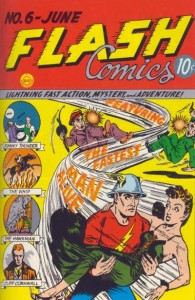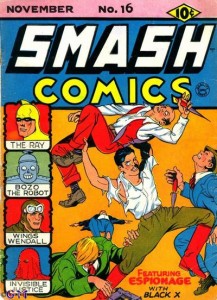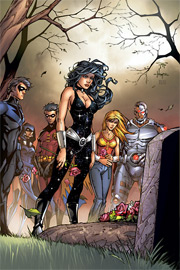 With current and former Teen Titans dying by the handful in DC’s big events, Infinite Crisis, World War III and Countdown, I’ve decided it’s time to take a look at the comics’ body count. Going back to the beginning of the team, which members have died? Which have come back? Here’s a list of all the dead Titans I could think of:
With current and former Teen Titans dying by the handful in DC’s big events, Infinite Crisis, World War III and Countdown, I’ve decided it’s time to take a look at the comics’ body count. Going back to the beginning of the team, which members have died? Which have come back? Here’s a list of all the dead Titans I could think of:
Category: Comics
Comics and the World War II Home Front
 Two months ago I picked up a copy of the comic book All-Flash #15 (Summer 1944), published during the thick of World War II. In the bottom margin of each page is a slogan, in rhymed couplet form, on how children could help with the war effort:
Two months ago I picked up a copy of the comic book All-Flash #15 (Summer 1944), published during the thick of World War II. In the bottom margin of each page is a slogan, in rhymed couplet form, on how children could help with the war effort:
- Bottom Lines on Following Pages Tell What to Do While Battle Rages
- Tin Cans in the Garbage Pile Are Just a Way of Saying “Heil!”
- Waste Fats in Good Condition Help to Make Fine Ammunition
- Boys and Girls, Every Day, Can Give War Aid in Many a Way—
- Every Time You Buy a Stamp, You Feed the Flame in Freedom’s Lamp
- If You Have an Extra Quarter, Buy a Stamp to Make War Shorter
- However far soldiers roam, the want to have some mail from home
- Collect Old Paper, Turn It In—Help Your Uncle Sam to Win
- You Can Walk to School and Store! Saving Gas Helps Win the War!
- Boys Are Smart, Girls Are Wise, Black Markets Not to Patronize
- IF YOU STILL HAVE METAL SCRAP, TURN IT IN TO BEAT THE JAP
- Turn Out Lights Not in Use —War Production Needs the “Juice”
Case and punctuation are preserved as closely as possible. Continue reading
Victimized Hero
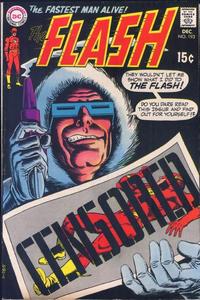 I didn’t think I had anything to add to the discussion on the infamous Heroes For Hire #13 cover. (Some of those links possibly NSFW.) Something stuck in my mind, though. Typolad suggested that “you would never, ever see Marvel or DC make a cover like this with a male protagonist. Yes, a male hero may be shown in peril, but his face will be defiant. He won’t be shown as submissive.” Lea Hernandez’ remix of the cover alters the expressions to do just that.
I didn’t think I had anything to add to the discussion on the infamous Heroes For Hire #13 cover. (Some of those links possibly NSFW.) Something stuck in my mind, though. Typolad suggested that “you would never, ever see Marvel or DC make a cover like this with a male protagonist. Yes, a male hero may be shown in peril, but his face will be defiant. He won’t be shown as submissive.” Lea Hernandez’ remix of the cover alters the expressions to do just that.
Now, I agree—that cover was way past the line, and I can’t imagine DC or Marvel doing the same thing with male characters, especially when you take into account the sleaze factor. But phrases like “never, ever” tend to read like a challenge. Looking just at the defiant/passive stance, I knew I’d seen at least one cover with the Flash beaten to within an inch of his life, unable to put up a fight or even a glare, so I took a trip through the Grand Comics Database’s cover gallery. Continue reading
Thoughts on Heroes: “How to Stop an Exploding Man”
The Heroes season finale was excellent. They did a good job of resolving the main story arc established at the beginning of the season (the bomb threatening New York City), balanced action and characterization, answered some questions while still leaving things open—and set up a really interesting situation for season 2.
It’s also nice to see that they’re keeping the weekly online comics going between seasons—and that they mentioned it during the broadcast. I think that’s a good move for keeping fan interest going until fall. I’m still hoping they’ll collect them in print, though. They could probably put everything concurrent with season 1 into a ~200-page trade paperback and sell it in bookstores. It would be a great companion item to go with the DVD set.
Now for more detailed thoughts on the episode. Spoilers follow: Continue reading
Showcasing the Flash
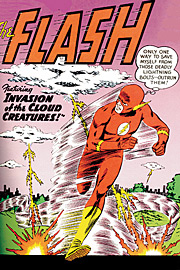 The first volume of Showcase Presents: The Flash came out today, reprinting ~500 pages of Silver-Age Flash stories in black-and-white for cheap. If you’re familiar with Marvel’s Essential line, it’s the same concept.
The first volume of Showcase Presents: The Flash came out today, reprinting ~500 pages of Silver-Age Flash stories in black-and-white for cheap. If you’re familiar with Marvel’s Essential line, it’s the same concept.
I took a look at it to see what stories were included. (DC’s solicits didn’t say.) As expected, it features the first several years of Barry Allen’s run as the Flash, from the original Showcase appearances starting in 1956 through the beginning of his series in 1959–1961. That includes the first appearances of the Elongated Man (who got his own Showcase Presents book last year) and Wally West as Kid Flash.
There was one surprise: “The Rival Flash,” from Flash Comics #104 (1949). That was the final issue of the Golden-Age series, and the last solo Jay Garrick adventure printed for years. I’d heard that the Showcase Presents books were making use of restoration done for DC’s Archives series, and this tracks: That same story also appeared in The Flash Archives Volume #1.
It also appears as a backup in The Flash #211 (1971), and is listed in the contents for the upcoming Flash: The Greatest Stories Ever Told, tying the origin story in Flash Comics #1 for the most-reprinted Golden-Age Flash story yet.
Full contents:
- Flash Comics #104 (1949)
- Showcase #4, 8, 13, 14 (1956–1958)
- The Flash #105–119 (1959–1961)
Super-hero Weaknesses
The suggestion box on my Flash site has picked up a couple of requests for the Flash’s “weakness.” The concept doesn’t really apply to the Flash’s powers, though. Thinking about it, if your hero has to have an off-switch, that’s kind of a sign that they’ve been over-powered, isn’t it?
It reminds me of a line that bothered me in Unbreakable. (Minor spoiler.) Samuel Jackson’s character explains to Bruce Willis that water is his Kryptonite. That’s hardly the case, though: a glass of water isn’t going to take him out of commission. He’ll still be invulnerable and super-strong while swimming. All it means is that he still has to breathe (and, presumably, eat and drink). A plastic bag over his head would be as effective as drowning.
Compare that to, say, Superman and Kryptonite, or Wonder Woman and being tied up, or past Green Lantern books and yellow objects or wood. It’s not in the same league (pun not intended).
Which brings us back to the Flash. What “weakness” does he have? Well, he’s a specialist, so he doesn’t have the advantage of super-strength or invulnerability. He can get tired. Like David Dunn, he has to breathe. He can get distracted. He can make mistakes. He can act without thinking. Are any of these really “weaknesses” in the Kryptonite sense, though?
Flash Smash Crash!
Hmm, I wonder how many newsstands displayed these books next to each other:
An explanation: I recently stumbled across a mention of Smash Comics, a series from Quality Comics that ran more or less concurrently with the more familiar Flash Comics. Just for kicks, I searched the Grand Comics Database (which is where I got the cover images) for Crash Comics, and found Crash Comics Adventures, which ran for 5 issues in 1940 before spinning off a series on the original Cat-Man. So the three books would have been on sale at the same time!
I couldn’t find any other books with the same pattern in the title. The GCD does substring matches, and “ash comics” only brought up variations on these three series. Though it did remind me that DC resurrected the Smash Comics title for one chapter of the 1999 The Justice Society Returns! event.
